No one wants a marine head that brings back memories of portable toilets, yet that’s exactly what we think of when holding tank chemicals are mentioned. Some of the chemicals bearing that familiar port-a-potty smell—disinfectants and surfactants mixed with deodorizers—are still being used in holding tanks. However, there’s a new generation of holding tank treatments that use enzymes and nutrients for bacteria to reduce odors more naturally, and we found, often more effectively. Some chemicals also claim to help liquefy the waste and prevent clogging. While larger boats can use vent filters and enhanced ventilation to reduce odors, the only practical option for the small-boat owner with a portable toilet is some sort of treatment in a can. (We will be looking at vent filters for holding tanks in the March issue of Practical Sailor.)
How do disinfectant treatments work? Aqua-Kem, a traditional and popular product in this category, contains formaldehyde, a traditional disinfecting agent. This is not healthy stuff; it’s listed by the Environmental Protection Agency (EPA) as a suspected human carcinogen. New buildings are limited by law to 16 parts per billion (ppb) and the Environmental Protection Agency’s action level for existing homes is 8 ppb. This amounts to a spill of about 0.0003 grams in a typical 35-foot boat, or about 1/13th of a drop. If enough is used, it will halt all biological activity, but that doesn’t mean it will kill all odor; the formaldehyde stinks, and there is still some chemical breakdown, so strong perfumes are loaded in with it, along with a powerful blue dye so that there is no mistaking it for a tall glass of spring water. Unfortunately, the dye also stains everything it touches. In our view, formaldehyde doesn’t belong on a boat, much less in a poorly ventilated area, such as the average marine head compartment.
The newer, enzyme-loaded products are known as bio-augmentation treatments, because they augment the natural biological processes. How do bio-augmentation treatments work? Some—such as Odorlos and TST Ultra Concentrate—work primarily by providing nitrate as both a nutrient and as an alternative oxygen source for bacteria. Bacteria convert nitrate to nitrite or nitrogen, liberating oxygen and encouraging aerobic decomposition. If nitrate is present in sufficient amounts, anaerobic and facilitative bacteria (bacteria that can quickly switch from aerobic to anaerobic metabolism, as conditions require) can use it instead of sulfate, which is present in both seawater and waste, as an oxygen source. This greatly reduces the production of sulfide, mercaptan, and organic-acid odors. In very simplified terms, the dominant reactions are these:
• Organics + O2 → CO2 + H2O + energy
• Organics + (NO3)- → N2 + H2O + energy
• Organics + (SO4)-2 → CO2 + H2S + energy
• Organics → CO2 + organic acids + CH4 + H2O + energy
TST Ultra Concentrate also includes sodium carbonate (washing soda), presumably to help disperse solids and buffer the pH upward. Decomposing wastes tend to become acid (low pH), aerobic bacteria prefer neutral pH, and hydrogen sulfide is far more volatile in acidic water.
How do enzyme and bacterial culture treatments work? Here we must guess, as the manufactures are tight with information. Presumably these mixtures contain a combination of nutrients, surfactants, aerobic bacteria, and enzymes, though we can only judge the results by measuring sulfide reduction and observing odor. We find claims that any sealed products contain live aerobic bacteria difficult to support, since the bottles will become anaerobic, and effectively, all of the aerobic bacteria will die within a few weeks. There are tricks to extend the life of these bacteria, but, as wastewater treatment experts will tell you, aerobic bacterial samples don’t remain viable for very long in a closed bottle. Enzymes can work—they are more stable and do most of what the bacteria would do—but they can’t multiply. They also break down in time, and must be added regularly and after each pump-out.
In the end, the complex chemistry and variable nature of the waste create a black box for the user—as well as for any tester. Given the variables that can impact this particular test, the best we could do is measure what we find, and in the case of biologically active treatments, add a little air in order to foster growth. For complete details on our testing procedures, see “How We Tested.”
WHAT WE TESTED
Treatment chemicals were obtained from a number of leading manufacturers. Although not a comprehensive field, it included the main players, many of which, such as Camco, are more familiar among RV aficionados. Other contenders included products from marine toilet makers Thetford and Dometic (under the SeaLand brand), and multinational chemical corporation Yara, the makers of Odorlos. Some smaller niche-players like Unique Distributing, makers of Marine Digest-It, and Nature-Zyme rounded out the field. One entry, VanishOdor, was unable to gain traction in this crowded field, so it pulled its product from the market before our test ended—a shame since it did well in testing. Since it is no longer available, VanishOdor was not included in the final results.
We also tested odor control in two tanks that relied solely on enhanced ventilation to promote the biological processes that combat odor. One tank used an oversized vent; the other was aerated with a fish-bubbler, which functions similarly to the Sweet Tank system offered by one of the oldest names in American marine plumbing: Groco.
OBSERVATIONS
Whatever happens with these treatments, it happens in one week, perhaps two weeks in larger tanks. Solids digestion evaluation is difficult to determine, in part because it’s too foul to measure quantitatively and also because agitation makes it quite variable; these solids break up quickly if the tank is shaken by the action of sailing in vigorous conditions. Thus, we gave only pass/fail ratings to solids digestion; if we saw lumps, it failed. Marine Digest-It and Nature-zyme, which fared well in the summer, failed this test in the fall.
Treated tanks contained far less hydrogen sulfide than the untreated tanks with equivalent ventilation, an indicator that all of the products did work. All were far better than the poorly ventilated, untreated tanks. Other than residual solids, which eventually could cause pump-out difficulties, the two things testers disliked were strong deodorant smells reminiscent of portable toilets and strong dyes that can cause staining.
Temperature makes a difference. The odor and hydrogen sulfide results reported the accompanying Value Guide were from our summer observations, since this was when odors were strongest and it is when most people sail. For fall and winter sailors and for those in cold-water areas (Maine, Pacific Northwest), the results were quite different. The bio-augmentation chemicals performed poorly in cooler weather. Vented tanks were also less effective, though the difference was less significant. Vent filters remained efficient year round. However, odors decline with temperature and true winter weather odor problems are very rare.
All of the products claiming to contain live bacterial cultures tested negative for bacteria. Control inoculations flourished, however, quickly producing both bacteria and fungus. But, we are not certain this is too important. The enzymatic properties of several products seemed capable of quickly reducing holding tank odor, and there is already plenty of bacteria in waste. Sewage treatment plants very seldom add cultured bacteria because of this. Additionally, many of the so-called anaerobic bacteria in waste are actually facilitative bacteria that are capable of either aerobic or anaerobic metabolism and can shift mechanism quickly when circumstances change. This change takes only minutes to hours, explaining why chemicals that add oxygen and enhanced venting can materially affect odor in less than 12 hours, far quicker than an aerobic culture could blossom. In time, as every sewage treatment plant operator learns, the optimum culture will establish itself based upon the governing conditions; the bacteria in the waste and these conditions overwhelm any minor biomass additions. Avoiding the addition of toxic chemicals—formaldehyde and related compounds, and bleach being the most common holding tank offenders—is the key to preserving healthy biomass.
FINDINGS
Holding tanks and waste are surprisingly variable, and this can have a great effect on odors. Like most ocean sailors, we used seawater flush for our testing. Seawater is known to contribute to odors. Many newer systems use freshwater, and very little of it. Others use several pints per flush. Temperatures vary, and ventilation varies. Clearly, individual tanks will be subject to a number of variables that our test tanks were not. To compensate for this, we tested all the chemicals more than once under different conditions. Those that showed the most merit in early testing underwent additional testing. All of the recommended products did well, and we encourage you to try each and see which one works best for your special circumstances.
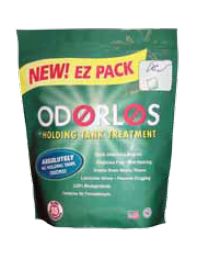
199
Odorlos
Containing nitrate as an active ingredient, this product is quite effective when holding-tank ventilation is provided. The liquid version has a green dye, but it is non-staining. We tested the powder version, which was convenient and without mess and perfumes. Among one of the most effective products in our test, Odorlos is a solid performer, and deserves its large following. We tested the 10-pack powder packet. Although the liquid version is the best-selling form, cruising sailors seem to prefer the powder, as it requires the least storage space.
Odorlos was one of our three recommended products. Pricing is competitive.
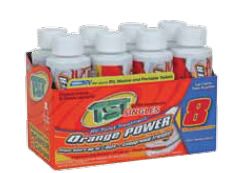
236
Camco
Camco is a major player in the world of RVs, and we tested two of its holding tank treatments. Its best-selling holding tank treatment, TST Ultra Concentrate, contains nitrate as an oxygen source and washing soda as a cleaner. It performed very well and was the least expensive of the group. The mild orange perfume was just enough and not overpowering; pine scent and “fresh” scent (as opposed to stale?) are available, but testers didn’t like these quite as well. PS testers focused on the powder form, as it seems most convenient to cruisers. A liquid is also available and performed the same in testing.
Camco’s other product, TST Advanced Enzyme, claims to break down organic matter, but this enzyme formula was too variable in our testing. It had no noticeable perfume.
Bottom line: Camco’s TST Ultra Concentrate is our Best Choice, and it is also one of the least expensive products in this test. PS does not recommend the TST Advance Enzyme product.

101
Marine Digest-It
Unique Manufacturing is a web-based company with its headquarters in Tucson, Ariz. Its range of anti-stain and anti-odor products address everything from wine spills to dog poop to septic tanks. Unique Marine Digest-It is an enzyme product without any dye or perfumes.
According to the maker, the bacteria in Marine Digest-It digests organic solids in the holding tank. The company claims that its product has a longer shelf life than similar products because the active bacteria is in a spore form.
Bottom line: The product was inconsistent in our testing. The dip slide test did not yield any bacteria cultures. Not recommended.
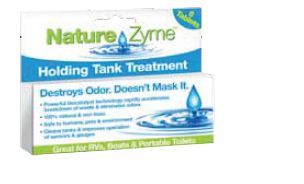
304
Nature-zyme
Sold in tablet form, Nature-Zyme is developed by Chicago-based Biowish Technologies. According to the maker, Nature-Zyme is an “all natural” product that removes odors and liquefies wastes inside vehicle and watercraft holding tanks and will continue to work after wastewater is emptied into dumping stations and finds its way into onsite septic systems at marinas and RV resorts. The maker claims that Nature-Zyme contains dry bacterial spores that, unlike many chemical treatments, will not harm septic systems, and will improve their treatment ability. The product is sold in pouches of 12 tablets, with each tablet treating holding tanks up to 25 gallons and costing about $1 each.
Bottom line: This convenient product did not control odor as well as others. The maker claimed it contained bacterial spores, but it failed to produce cultures in our test. At press time, the product appears to have been pulled from the market. We will pass on this.

280
Dometic Max Control Advanced
Dometic is a major force in the world of marine and RV sanitation, making everything from holding tanks to hoses to heads. Its low-water VacuFlush system has become a standard on many larger yachts. Its advanced formula Max Control did not contain any formaldehyde, but the perfume was quite strong. Its inconsistent odor control and staining blue dye put it near the bottom of the field. SeaLand recently introduced a new environmentally friendly formula, which we will test this summer.
Bottom line: Not recommended, but given SeaLand’s expertise in this field, the newer product is worth a shot.

177
Thetford Aqua-Kem
Thetford is another big player in the marine sanitation game. Its electric-flush EasyFit toilet earned a Budget Buy rating in our test of marine toilets (March 2011). Containing powerful dye and powerful perfumes and odors, Thetford’s Aqua-Kem also contains formaldehyde, making it a non-starter in our view. Fortunately, Thetford has a very good alternative. A bio-augmentation and enzyme formula, Thetford Eco-Smart, performed much better and was safer and less messy to use. It is available in economy size bottles, small single-dose bottles, or as a toss-in bubble pack.
Bottom line: Thetford Eco-Smart earns a Recommended rating; avoid Aqua-Kem.

CONCLUSIONS
Chemical treatments that relied on disinfection, surfactants, and deodorants were generally better than nothing, and they did a serviceable job of reducing solids. However, none of them controlled odor very well, most were messy, and all left a characteristic portable toilet aroma behind. Even if the waste odors were gone—and it was not—they would be distasteful. We do not recommend this class of products.
Good tank ventilation helps significantly, particularly in the absence of chemical treatment, though it was not as effective alone as the better treatments. Combined with bio-augmenting chemical treatments, well-ventilated tanks effectively controlled odor. Larger vents make good sense and will reduce odors in boats that are left unattended for weeks at a time. Our bubbler system, intended to model the effect of the Groco Sweet Tank System, offered some improvement over natural ventilation. In a larger tank or one where good ventilation is very difficult to achieve, this offers a viable and robust approach.
Bio-augmentation treatments, particularly the recommended treatments, did a fine job of reducing tank solids and controlling odors. The only challenge, which we were not able to adequately investigate, is that they may not last long enough to work in boats that sit unused for three weeks or longer, which can prevent the exchange of air. One solution is to go sailing more often. Another solution is to increase the vent size so that natural ventilation helps these treatments work optimally.
None of the treatments were effective when the air exchange was overly restricted by a long vent line or a vent filter. The conventional wisdom that a vent line can be no longer than five feet, no smaller than ¾-inch inside diameter, and have a rise no more than 18 inches, has proven sound.
How do chemical treatments, vent filters, and enhanced tank ventilation compare? After many months spent lugging waste and comparing results, we’ve learned all can work, but that each approach has limitations. Good tank ventilation seems a good place to start, supplemented with chemical treatment as needed. The Sweet Tank System can be the answer when good ventilation is otherwise difficult to achieve or the tank is very heavily loaded. For sensitive vent locations (near cockpits, hatches, ports, etc.), vent filters offer the best odor control if a good installation can be achieved. However, the elevated hydrogen sulfide levels in these tanks may increase permeation risk over the long term. We are currently running some long-term tests of hoses and vent filters. Fortunately, the total costs of all of these odor control approaches, taken over time, are low. Stay tuned for our reports on vent filters and hoses in the forthcoming issues.

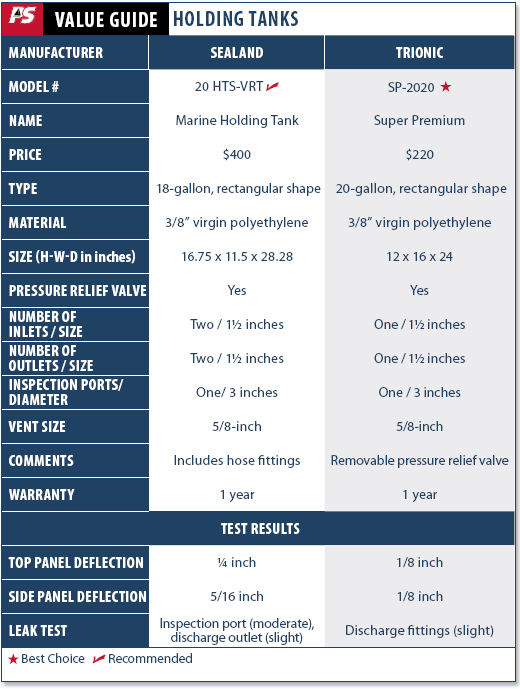


































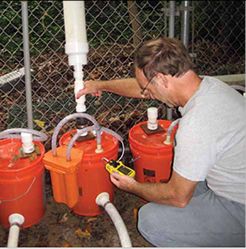





Great articles very informative and helpfual
The body of the article says PS does not recommend Camco’s Advanced Enzyme Product, but in the Value Guide, it is “Recommended.” Which is it?